Nyamkhuu Baatar
Nomad art from Mongolia
Today we present you the interview with Nyamkhuu Baatar, a well-known skilled Mongolian artist. He is the founder of the "Mongolian Art Society", an award-winning artist of the "Union of Mongolian Artists" and a teacher of Mongolian art at the "Academy of Fine Arts".

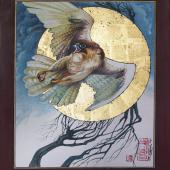
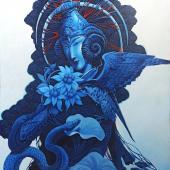

artist ritual: Hello Mr. Baatar, thank you very much for accepting our invitation and agreeing to interview yourself and your pictures for our magazine.
Mr. Baatar: I would also like to thank the staff of your magazine for inviting me.
artist ritual: What role does art play in your life?
Mr. Baatar: First of all, I love art. Art helps a person express their dreams and what that person wants to do. Nobody asks me to paint, but the fact that I connect with it on my own initiative is the most amazing thing. A person is born into this world and faces many problems. Life criteria, family life, work stress, etc. But I would like to say that art helps me to get away from all my problems and meet myself. I feel most comfortable in my art studio. When I walk into my studio and see a blank canvas, I can't put into words the feeling I had then, it stimulates my desire to paint. To put it bluntly, it drives me crazy. There are days and sometimes even months of thinking to start a painting. Art defines who I am in my life. I think the meaning of life is to do what you want, when you want. For me, it's normal to leave the house at 2 a.m. and come to the art studio to paint. But it's very rare to find someone who understands that. Being a family of artists requires a lot of perseverance. It is necessary to understand psychology and desire. I think I do my art to this extent because my wife understands me. Art people are married much less often than ordinary people. The main thing is to find someone who understands you.
artist ritual: What are your inspirations for your art?
Mr. Baatar: I was born into this world as a human being, so I am inspired by everything. Artists are people who love beauty. An artist feels the beauty of nature, the beauty of women, and even the beauty of colors when he mixes colors. Art is not only beautiful. As an artist, I want to express all my emotions in my paintings. For example, love, anger, pain, fear, hate, etc. My painting is finished when I express all this in my artwork, what I want to show. So inspiration is limitless. The beauty of a woman cannot be defined only by a woman. But you can define beauty by looking at the woman you love. Because the artist feels the essence and beauty of the woman he loves in his heart. After a lot of research, the artist has a little skill to portray the perfect beautiful woman. Therefore, I think inspiration can be called a boundless ocean.
artist ritual: What typical art of painting do you find difficult?
Mr. Baatar: I tried six times and failed to draw the third part of the musical Moonlight. It is wonderful music that shows the pure image of women in this 3rd generation. Beethoven himself said after he finished his music, "Play it as fast as you can." This fast beat has a great rhythm that shows the strength and freedom of a woman. I can't draw that. Portraits are the most difficult, in my opinion. Because a portrait is not about looking the same. When painting a portrait, the artist must recognize the spirit body and essence of the person he is painting. Anyone who is interested in drawing can copy and draw the same thing. It is very difficult to see the inner soul of the person you are painting.
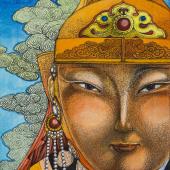
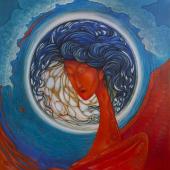

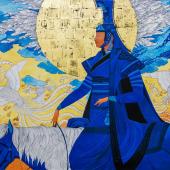
artist ritual: You said essence. What is essence for you?
Mr. Baatar: Simply said, this word is the spiritual quality of a thing or person. For example, painters paint nature (Natural Figure with Model) to give life to their work. Who is the model? Because an artist is looking for what that person's inner world expresses through their appearance, body, face and gaze. In a sense, this means that the artist is conducting a study of feelings and beauty in living bodies and objects. An example is the medieval classic Romeo and Juliet, which is still famous for its depiction of true love. What is a classic? The answer to this question is that people create art for themselves to move people's emotions. Romeo and Juliet became a great classic because Shakespeare did so by showing the inner feelings and values of love, touching people's hearts and affecting people's lives. There are also many great classics in nomadic cultures, which is certainly different from the West. One thing I find very sad, and that is that the settlement culture in the 21st century is very damaging to nature. The nomadic culture used to treat water and avoid pollution. In the Great Government Law, it was even legislated that it is forbidden to pour milk and sewage into rivers and lakes. This is the principle of living in harmony with nature. It is a pity that mankind is only now understanding the essence of nature.
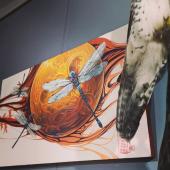
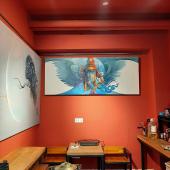


artist ritual: How would you define your style? What techniques do you use to create your artwork?
Mr. Baatar: I studied Mongolian painting and acquired traditional techniques. If I should define it clearly for others, then I can say that I am interested in visualizing the culture of the nomads with the Mongolian painting technique. Therefore, it can be said that I use and practice the technique of Mongolian painting. Art historians and art critics are the ones who define art, but the artist creates his work. Art scholars define the style of the finished work. However, it is basically not necessary to paint with the Mongolian painting technique. The artist applies what he has learned to draw in his own style. My paintings come from within me. Nomadic art itself tends to be very free and meaningful. What? How? For what purpose? I think that an artist should be able to answer the basic questions of his subjects with his drawings. The technique of Mongolian painting is my painting technique.
artist ritual: Which drawing and painting materials do you prefer?
Mr. Baatar: I prefer the traditional fabric and earth colors of Mongolian painting. However, due to the lack of earth paints in Mongolia, paintings are often done with acrylic and oil paints on canvas. Watercolors are also very nice.
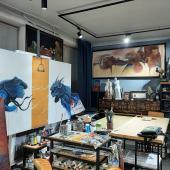
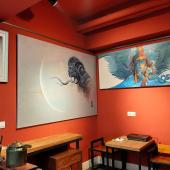
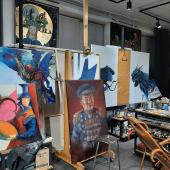
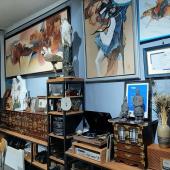
artist ritual: What difficulties and challenges did you face when you became an artist and created your art?
Mr. Baatar: I didn't have any problems at first. As a child, I was a very athletic child. I took and passed the exam at the School of Arts and Crafts at my own request. From that moment my way as an artist was paved. I first studied Mongolian painting at the Secondary School of Fine Arts. After graduating from high school, I had a very strange feeling. The strangest thing was that I used to go to school every day and paint pictures, it was very strange for me after graduation. New students then came to my class where I used to sit and draw all the time. At that time, there was a kind of feeling for me that there was no place to go. After graduation, I painted small paintings and sold them to tourists. I used to sell my paintings for five or ten dollars. After that, I worked as a theater stage designer. In 1996, with two friends, I had covered 99% of the surface of the Janraasag deity of Gandan with gold plates in five months. Sometimes when I visit Gandan, I see the color of the god covered with gold. In October 1996, I first joined the School of Fine Arts as an assistant teacher, and in 1999, I took charge of my own first class and started teaching. It can be said that since that time I have been co-teaching my own work.
artist ritual: What role does research play in your creative process?
Mr. Baatar: An artist is no one without research. Now I have painted a picture called "2 lunar day". To paint this picture, I had to know the characters 2 lunar day. A painting without research is like a body without a soul. Without research, without content, without essence, no good works of art are created. For example, there is a story of Van Gogh researching Hiroshiya's painting, and repainting it with oil paints. That is research, not plagiarism. The main thing is to learn what you want to learn and incorporate that knowledge into your own work. As a teacher, that's what I tell my students. You can learn a lot from great artists.
artist ritual: How does the criticism of others affect your creative process?
Mr. Baatar: To be honest, not many people have criticized my photos. Of course, there are people who share their thoughts and give advice about my pictures. I think it's something to be grateful for. I'm not afraid of criticism. Because I'm just a human being. The perfect human being does not exist.
artist ritual: Thank you very much for your time today. It was a pleasure to ask you questions and talk to you, and I wish you every success in your future work.
Mr. Baatar: I also wish you much success in your work.


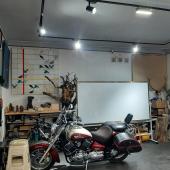
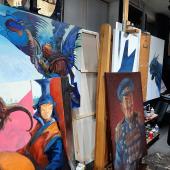
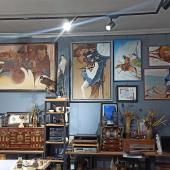
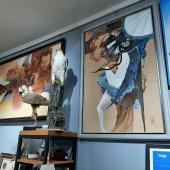

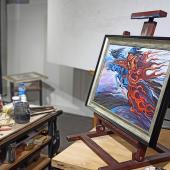
Vita Nyamkhuu Baatar
Contact details
- Phone: +976-11-362428
- Cell: +976-99178244
- Email: bnyamkhuu2002@yahoo.com
- Adress: Institut für Bildende Kunst P.O.B,-223, Ulaanbaatar 46 Mongolei
Education
- 1991 Graduated from the College of Fine Arts
1991-1994 Institute of Fine Arts, Mongolia, Bachelor's degree - 2007-2009 Mongolian University of Science and Technology, master's degree in graphic design
- 2014 Mongolian State University of Art and Culture, PhD in Art Studies
Work experience
-
since 1996 Lecturer at the Institute of Fine Arts /Academy of Fine Arts/
-
since 1996 Member of the Union of Mongolian Artists
-
2002-2008 Director of the community "Mongol zurag
-
2004-2008 Member of the Board of the Union of Young Mongolian Artists
-
2013-2014 Head of the Department of Traditional Arts at the Academy of Arts
-
since 2013 Board member of the Centre for Mongolian Heritage Studies NGO
-
since 2017 Board member of the Union of Mongolian Artists
-
since 2019 Board member of "Children's home" Co.,Ltd
-
since 2020 Head of the "Mongol zurag" community
Solo exhibitions (excerpt)
- 2014 "University" exhibition at "Siqintana Art Museum", China
- 2008 "Portrait" PYO Gallery, Seoul, Korea
- 2007 "Faraway" exhibition at Goyang National Art Studio, Korea
- 1995 "Mongol Zurag" exhibition at the Embassy of the USA in Ulaanbaatar, Mongolia
- 1994 Exhibition "Around the World" /Academy of Fine Arts/, Mongolia
Selected group exhibitions
- 2022
- "Best of year" /Academy of Fine Arts/
- "Baatartai haalga" at the MN-17 Gallery
- "Autumn" /Academy of Fine Arts/
- "Bid Urlagiinhan" /Academy of Fine Arts/
- "Best of Mongol Zurag" Community for Mongolian Art
- "Contemporary of Mongol zurag" Community for Mongolian Art
- 2021
- "Mongol Zurag" Community for Mongolian Art
- Ministry of Culture of Mongolia "Creative Month"
- 2020
- "Spring" and "Autumn" /Academy of Fine Arts
- "Best of the Year" /Academy of Fine Arts
- "Oron zai" /Academy of Fine Arts
- 2019
- "Mongol Zurag" Community for Mongolian Art
- "Oron zai" /Academy of Fine Arts
- 2018
- "Spring" and "Autumn" /Academy of Fine Arts
- "Best of the Year" /Academy of Fine Arts
- "Oron zai" /Academy of Fine Arts
- 2017
- "Spring" and "Autumn" Society of the School /Academy of Fine Arts
- "Best of the Year" /Academy of Fine Arts/
- "Deajong International Art Exhibition" in Deajong
- "Oron zai" /Academy of Fine Arts/
- "Grand Art" as guest artist
- 2016
- "Culture of Steps" in Khukh khot, Inner Mongolia, China
- 2015
- "Korean and Mongolian Artists 12" in Daejeon City, Korea
- "Mongol zurag" community for Mongolian art
- "Oron zai" /Academy of Fine Arts
- 2014
- "Mongol zurag" exhibition at the 5th Fukuoka Asian Art Triennale 2014", Japan
- "Mongol art" exhibition at Tejoun, in Korea
- 2013
- "Oron zai" Society of the School of Fine Arts /Academy of Fine Arts
- 2012
- "Oron zai" Society of the School of Fine Arts /Academy of Fine Arts/
- "Mongol zurag" Community for Mongolian Art
- 2011
- "Mongol zurag" Community for Mongolian Art
- 2010
- Joint exhibition by art professors from 10 countries, Korea
- 2010
- Exhibition "Portrait" at the UMA /Union of Mongolian Artists
- 2009
- Group exhibition of Mongolian artists, at the "Sejoung" Centre, Korea
- Exhibition " Fresh works " at the UMA
- 2008
- Group exhibition of artists from Russia, Korea and Mongolia, in Russia
- 2007
- Pocheon Asian Biennale 2007, Korea
- Sosabeol International Art Exhibition in Pyungtaek, Korea
- Adoptee & Alain Visions from the Perrphery, Kyunghee University, Seoul, Korea
- 2006
- Collective exhibition Yokohama, Civil Gallery of Art, Japan
- Exhibition "Mongol zurag" in Russia 2005 Touring exhibition in European countries
- 2000
- Exhibition "The Colours of Mongolia" in New-York and San Francisco,
- "EXPO-2000" in Germany
- Exhibition "Mongol zurag-1" at the Museum of Fine Art
- Exhibition "Our line and our colour" Ulaanbaatar, Mongolia
- Annual exhibitions "Spring" and "Autumn", organised by the Union of Mongolian Artists
- 1996
- Master goldsmith of the "Megjid Janraiseg" religious statue foundation
- since 1996
- annual exhibitions organised by the "Oron zai" society
Participation in exhibitions as organiser and as head of the "Mongol zurag" society
- 2008 "Mongol zirag-6" annual exhibition of the "Mongol zurag" community
- 2007 "Mongol zurag" Community
- 2006 "Mongol zurag" Community
- 2005 Exhibition "The Secret History of the Mongols", organised by professional painters
- 2005 Annual exhibition of the "Mongol zurag" community
- 2003 Annual exhibition of the "Mongol zurag" community
- 2002 Exhibition of the "Mongol zurag" community at the opening ceremony
Awards
- 2005 Head of the Union of Mongolian Artists
- 2006 Government Medal, Mongolia
- 2013 Meritorious Cultural Worker
- 2017 Polaris of Governmental, Mongolia
- 2019 "Best of the Year" of the Mongolian National Art Gallery
- 2021 Recipient of the Order of the Red Banner of Labour (Mongolia)
- 2022 Bearer of the 30th anniversary of the democratic revolution
Works of art in collections
- University of the Sorbonne, Paris, France
- Khan Bank Modern Art Collection, Ulaanbaatar, Mongolia
- Embassies of the USA and England in Mongolia,
- Private collections in the USA, Japan, Germany, Italy, Spain...
Organised activities
- 2011-2014
- Set designer of the "Mongolian Naadam Festival".
- Scenographer of the documentary film "Secret of Black Fierce Emblem
- since 2012
- Organiser of the "Brotherhood with Bruises" competition of the Cultural Information Centre of the City of Seoul and the School of Fine Arts and Culture of Mongolia
- since 2012
- Organiser of the joint project "Image and Ethnic Character Formation of Mongols" with Inner Mongolia
- 2013
- Open University Scenic Artist in the Streets-2013
- 2013
- Organiser of the "Falcon Art" competition with the "Bird Hunting Association".
- 2013
- Organiser and artist of the "Fine Arts Festival" Ulaanbaatar, Mongolia
- 2013
- Chief judge of the Talent is Aspiration competition for a humanitarian competition programme
- 2014
- Stage designer for the "International Children's Day" event in Ulaanbaatar
- since 2014
- Consultant for the animated film "Divine Warriors" by "Tsog" picturtes
- 2015
- Stage designer of "Inverted Triangle", an ethnomodern ballet
- Set designer of "Four Seasons" project art dance show
- 2016
- Set designer of "Secret of Black Fierce Emblem" documentary film"/peace film award of the Berlinale/.
- Set designer of the musical "Galaikhan", organised by the State University of Art and Culture of Mongolia
- 2017
- Marketing Manager for the 75th anniversary of the UMA /Union of Mongolian Artists/.
- Chief Juror of the "Great Art Exhibition" organised by Young Artist's at the Union of Mongolian Artists and South Korea.
- 2019
- the ethnic dance performance "Inverted Triangle" was performed at UNESCO headquarters in Paris, France. The dance performance was written based on the studies of professors and students of the Mongolian State University of Arts and Culture in 2015. The event was organised by the Mongolian National Commission for UNESCO, the Permanent Delegation of Mongolia to UNESCO and the Mongolian State University of Arts and Culture.
- 2020
- Graphic designer of the children's book "Mongolian Secret History" and the second part of the edition "Chinggis Khaan of Great Mongolia".
- General artist for the construction of the "13th Century" complex, the 2229th anniversary of Mongolian statehood, the 814th anniversary of the founding of the Great Mongolian state, the 99th anniversary of the People's Revolution and the "Naadam Festival".
- 2021
- The main artist of the musical "Bosoo Tsagaan gurvaljin"



















- Reply
Permalink